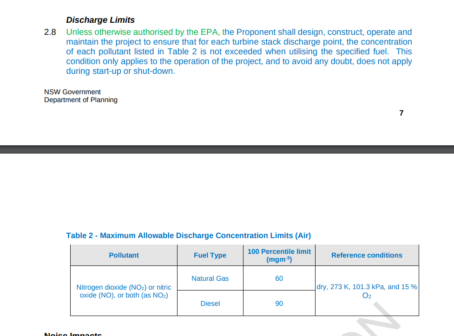The Coast’s very own Colongra open cycle gas fired power station has been operating at historically high levels in recent months shoring up electricity supply to NSW.
Colongra, near the defunct Munmorah power station, operates as a peaking plant, supplying electricity at short notice during periods of peak demand or system emergency situations.
In June, the power station owners, Snowy Hydro, sought an urgent meeting with the Department of Planning and Environment (DPE) to fix an administrative anomaly on air concentration limits that meant when the station cranked up its output, it was constrained by one of the conditions of consent.
The company explained to the DPE that there were inconsistencies between conditions of Colongra’s Environmental Protection Licence (EPL) and Condition 2.8 of Colongra’s Planning Approval on alternate air concentration limits and exemptions.
These inconsistencies were preventing Snowy Hydro from utilising the exemption granted by Environmental Protection Authority (EPA) without breaching Condition 2.8. of the Planning Approval to maintain reliability of the NEM (national electricity market).
The facility operates under Ministerial development consent issued in 2006 which permits an output of 660 megawatts (MW) via four turbines fired through both gas and diesel fuel.
However, the development consent imposes limits on nitrogen oxide (NO2) emissions for turbine stack discharge points.
The facility’s Environment Protection Licence (EPL) regulated by the Environment Protection Authority (EPA) contains these same limits.
In October 2020, the facility’s EPL was varied to allow for the temporary exceedance of air concentration limits, during emergency circumstances.
But the trouble was, this emergency exceedance provision was not included in the development consent.
Until now.
Snowy Hydro requested an urgent administrative modification to Condition 2.8 of Colongra’s Approval to ensure consistency between the EPL and the Planning Approval.
Earlier this month the Department of Planning and Environment approved the modification.
The modification added six words to Condition 2.8: “Unless otherwise authorised by the EPA”.
Condition 2.8 now reads: Unless otherwise authorised by the EPA, the Proponent shall design, construct, operate and maintain the project to ensure that for each turbine stack discharge point, the concentration of each pollutant listed in Table 2 is not exceeded when utilising the specified fuel.
The pollutant is Nitrogen dioxide (NO2) or nitric oxide (NO), or both (as NO2) and it has maximum allowable concentrations which differ depending on the fuel used.
The approval permits Snowy Hydro to utilise the air concentration limit emergency exceedance condition granted by EPA to respond to the energy crisis.
This allows it to comply with Australian Energy Market Operator’s direction to maintain and restore security and reliability of the NEM.

The Department said it was not required to notify or seek public submissions on the application because it was administrative in nature.
The Department made the Modification Report available on its website and consulted with the Environment Protection Agency.
“No change is proposed to the prescribed NO2 discharge limits in the development that would be in effect during normal operating circumstances,” the consent states.
The Department considered the proposed modification was in the public interest.
Colongra power station ordinarily operates on natural gas, but, under conditions where natural gas is unavailable, will operate on diesel.
Council Watch approached Snowy Hydro for a comment.


